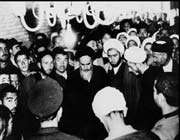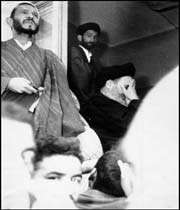Special Features on Khordad 15 Uprising
For casual foreign observers, unfamiliar with the events in Iran, the victory of the Islamic revolution in February 1979 may have appeared unexpected. Some have called it the biggest political earthquake of the century. In Iran, however, there was a different viewpoint among the masses of people and the revolutionaries. The fire was simmering since the June 5, 1963 when Imam Khomeini launched the uprising against the detested regime of the British stalled and American-supported Pahlavi Shah, and it was only a matter of time for the flames to shoot up and devour the monarchy and its foreign backers. The Islamic Revolution that triumphed in 1979 was thus not a spontaneous occurrence, or culmination of the unrest that flared into the open a year earlier, following the printing of an insulting article against Imam Khomeini by the Shah’s regime.
The Father of the Islamic Revolution correctly described the victory of the Islamic Revolution as the explosion of light. It meant that sparks that he had ignited with the help of the people June 5, 1963, or the 15th of Khordad, were now manifest to the world in the form of a dazzling light.
In 1963, the Muslim people of Iran expressed their anger and opposition to the US political and economic hegemony over the country by holding rallies in the holy city of Qom, Tehran and other cities, shouting slogans against the Shah’s tyrannical regime as well as the US. The regime, which after its illegal restoration to power on 19th August 1953 through the CIA coup, was facing such open opposition for the first time.

It savagely and suppressed the peaceful demonstrations by massacring thousands of people. The June 1963 uprising showed that people’s aspirations were for the Islamic system of government and not for any superficial reforms initiated by the regime. The major demands of the people were support for Imam Khomeini, the overthrow of the Shah and cutting of US hands from the country. The US media lost no time in branding the uprising as a reactionary move and of no significance for the government and the Americans, although they hatched plots to imprison Imam Khomeini and then exile him, first to Turkey and then to Iraq. The propaganda may have deceived world public opinion but it had no effect on the people of Iran or their struggle against despotism and foreign domination, the factors that were singled out as the two main enemies of freedom and independence of Iran. Since he was reinstalled on the Peacock Throne in 1953 by the US after the coup against the legal and popular government of Iran, the Shah never spared any effort to crush the Iranian Muslim people. So severe were his pressures that anti-American feelings intensified in Iran, similar to the situation in Latin American and other countries groaning under American supported dictatorships. In the 1960s, US president John Kennedy thought that anti-American movements would subside and die out if some sort of superficial economic and political reforms are made in such countries including Iran under the slogan of progress.
As part of this deception the Shah was ordered to start his so-called White Revolution, which actually gave more concessions to the US and passed a law granting immunity to Americans in Iran even if they commit a crime against the Iranian people and country.
This humiliating bill by the rubber stamp Majlis of the Shah angered the people. It became known as the Bill of Capitulation. Imam Khomeini spoke against it and also cautioned the people from taking part in the sham referendum arranged by the monarchy to legalize its crimes against the people and total subservience to the US.

The farsightedness of Imam Khomeini saw through the deception of this plot. He did not restrict himself to the releasing of statements of denunciation but spoke openly from the pulpit against the crooked measures. Imam Khomeini was detained but this measure only intensified the people’s anger, and they poured into the streets to protest. The Shah and his American backers managed to bloodily crush the uprising of June 1963 but they could not snuff out the flame of the aspirations of the Iranian people for Islamic rule. In fact, the blood of the martyrs irrigated the fertile soil and 16 years later the tree of the Islamic grew and spread out its branches to welcome Imam Khomeini back home to Iran from exile.
The Islamic Revolution thus triumphed under the enlightened leadership of the Imam and it threw into the dustbin of history the Shah’s hated regime.
It brought independence and freedom to the Iranian people and cut off the hands of the Americans from Iran and its rich natural resources. The 15th of Khordad uprising is thus the base on which the edifice of the Islamic Revolution was built. Today, a quarter century has passed since the triumph of the Islamic Revolution and the end of American hegemony. Hope the enemies have learnt the lessons. Try what nefarious plot it may, the US will not be able to re-impose its yoke on the faithful and powerful Muslim nation of Iran.
other links:
Biography of Imam Khomeini
Political aspects Of Imam Khomeini
Imam Khomeini's Objection to Capitulation Bill and his disclosuring the regime's plans